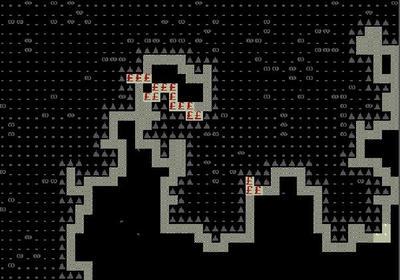- v50 information can now be added to pages in the main namespace. v0.47 information can still be found in the DF2014 namespace. See here for more details on the new versioning policy.
- Use this page to report any issues related to the migration.
Difference between revisions of "40d:Vein"
m (size of large clusters, magnetite) |
m (→Veins and Clusters:: typo - "saphire") |
||
| Line 19: | Line 19: | ||
[[Image:Eroded vein.PNG|thumb|center|400px|A single vein of hematite has been exposed on a hillside on the surface, cut and heavily reduced by erosion. The final count was ''far'' below average, not much more than twice what is visible.]] | [[Image:Eroded vein.PNG|thumb|center|400px|A single vein of hematite has been exposed on a hillside on the surface, cut and heavily reduced by erosion. The final count was ''far'' below average, not much more than twice what is visible.]] | ||
| − | It is common to find certain gemstones embedded only in certain veins or large clusters. For instance, to find rubies and | + | It is common to find certain gemstones embedded only in certain veins or large clusters. For instance, to find rubies and sapphires, explore [[bauxite]] clusters; for [[diamond]]s, one should follow any [[kimberlite]] veins they find, which in turn are found only in [[gabbro]] [[layer]]s. Knowing what stone (or ore) contains what veins and clusters can be useful in [[exploratory mining]] or understanding the information given to you before you embark on a new game, and complete information for each can be found on the wiki page for that stone/ore/gem. |
| − | |||
===See also:=== | ===See also:=== | ||
Revision as of 04:06, 8 May 2009
Veins and Clusters:

Veins and clusters, fully revealed. Note this unusual copper (brown) vein has been folded over and reconnects with itself, and also overlaps one of the two hematite (red) veins. Also note the brown gems in the very top of the center hematite vein, and the various small clusters of gems across the level. The bottom quarter of a large cluster (of non-valuable stone) is at top right, with a small cluster of native aluminum (white chevrons) below it. This area is well above average - some areas this size have nothing to offer but callouses and disappointment.
(This view uses a 3rd party utility, and is not possible in the normal game.
Non-layer stone occurs in these patterns:
- Large cluster - An oval that occupies nearly half of a 48x48 block, area-wise. These huge ovals consistently measure near 20 x 40 tiles, and average perhaps 700 stones each. Only one appears per block, and while veins and small clusters can be found in them, large clusters are usually not a valuable stone, magnetite being one notable exception.
- Vein - A sinuous line of the material crosses part of the block. These average about 100 stones each, and vary from 1-5 tiles wide within a single vein. When a vein ends, it does not start again unless it was broken by another vein, cluster or erosion (see below).
- Small cluster - A sprinkle of 1 to 9 adjacent tiles. Multiple small clusters of different materials may be in the same block. These average 4-5 adjacent stones each and do not span more than three tiles in each direction. (That is, all tiles are enclosed in a 3x3 square area.)
Rarely, two separate veins (of same or different stone/ore) can be found "doubled", two next to each other, or (also rarely) folded back on themselves. Unrelated veins and clusters can intersect or overlap with each other - only one type of stone/ore/gem will be found in any one tile, however.

Note that erosion (during world-gen, pre-embark), magma (pools and pipes), water (brooks, rivers and pools), pits and chasms may reduce exposed veins and clusters to a fraction of their original starting size, and/or cut through them, exposing only the remnants, or two parts of a single vein in two nearby areas on the same z-level.
It is common to find certain gemstones embedded only in certain veins or large clusters. For instance, to find rubies and sapphires, explore bauxite clusters; for diamonds, one should follow any kimberlite veins they find, which in turn are found only in gabbro layers. Knowing what stone (or ore) contains what veins and clusters can be useful in exploratory mining or understanding the information given to you before you embark on a new game, and complete information for each can be found on the wiki page for that stone/ore/gem.
